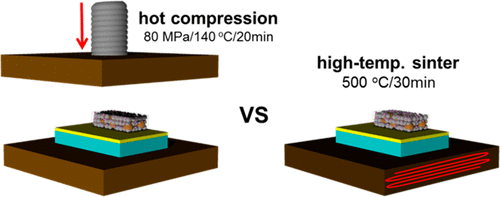当前位置:
X-MOL 学术
›
ACS Sustain. Chem. Eng.
›
论文详情
Our official English website, www.x-mol.net, welcomes your
feedback! (Note: you will need to create a separate account there.)
Direct Comparison of Electron Transport and Recombination Behaviors of Dye-Sensitized Solar Cells Prepared Using Different Sintering Processes
ACS Sustainable Chemistry & Engineering ( IF 7.1 ) Pub Date : 2018-04-18 00:00:00 , DOI: 10.1021/acssuschemeng.8b01351 Yuelong Li , Xiaodan Zhang , Min Jae Ko 1
ACS Sustainable Chemistry & Engineering ( IF 7.1 ) Pub Date : 2018-04-18 00:00:00 , DOI: 10.1021/acssuschemeng.8b01351 Yuelong Li , Xiaodan Zhang , Min Jae Ko 1
Affiliation

|
Flexible dye-sensitized solar cells on plastic substrates have achieved a conversion efficiency of 8.6% with the hot compression technique (<150 °C). However, the value of efficiency is only 70% of that achieved using glass substrates with high-temperature sintering technique (500 °C). Investigating the origin of this difference is a critical step for further improving the performance of plastic dye-sensitized solar cells. In this study, an optimized ternary viscous titania paste without the addition of organic binders enables the fabrication of efficient dye-sensitized solar cells with a low-temperature process. Therefore, the electron-transport behavior of dye-sensitized solar cells can be directly compared with those prepared with the high-temperature sintering technique. In addition to the structural and optical differences, the hot compressed photoanode of dye-sensitized solar cells have an electron diffusion coefficient that is 2 times smaller and a recombination time that is 6 times shorter than those of the high-temperature sintered cells, suggesting inadequate interparticle connections and more recombination events. These results indicate that electron transport and recombination are still the key factors governing the performance of low-temperature fabricated dye-sensitized solar cells. Eventually, the flexible cell with an efficiency of 6.81% has been achieved on flexible indium tin oxide/polyethylene naphthalate substrate. Further improvements in advanced low-temperature processing or novel materials with minimized defect or grain boundaries are required.
中文翻译:

直接比较使用不同烧结工艺制备的染料敏化太阳能电池的电子传输和复合行为
通过热压缩技术(<150°C),塑料基板上的柔性染料敏化太阳能电池的转换效率达到了8.6%。但是,效率值仅是使用具有高温烧结技术(500°C)的玻璃基板所能达到的效率的70%。研究这种差异的根源是进一步提高塑料染料敏化太阳能电池性能的关键步骤。在这项研究中,优化的三元粘性二氧化钛糊剂无需添加有机粘合剂,即可通过低温工艺制造高效的染料敏化太阳能电池。因此,可以直接将染料敏化太阳能电池的电子传输行为与用高温烧结技术制备的电子传输行为进行比较。除了结构和视觉上的差异外,染料敏化太阳能电池的热压缩光阳极的电子扩散系数比高温烧结电池的电子扩散系数小2倍,重组时间比高温烧结电池短6倍,这表明粒子间连接不足且发生了更多的重组事件。这些结果表明,电子传输和复合仍然是控制低温制造的染料敏化太阳能电池性能的关键因素。最终,在柔性氧化铟锡/聚萘二甲酸乙二醇酯基板上获得了效率为6.81%的柔性电池。需要进一步改进先进的低温加工工艺或缺陷或晶粒边界最小的新型材料。
更新日期:2018-04-18
中文翻译:

直接比较使用不同烧结工艺制备的染料敏化太阳能电池的电子传输和复合行为
通过热压缩技术(<150°C),塑料基板上的柔性染料敏化太阳能电池的转换效率达到了8.6%。但是,效率值仅是使用具有高温烧结技术(500°C)的玻璃基板所能达到的效率的70%。研究这种差异的根源是进一步提高塑料染料敏化太阳能电池性能的关键步骤。在这项研究中,优化的三元粘性二氧化钛糊剂无需添加有机粘合剂,即可通过低温工艺制造高效的染料敏化太阳能电池。因此,可以直接将染料敏化太阳能电池的电子传输行为与用高温烧结技术制备的电子传输行为进行比较。除了结构和视觉上的差异外,染料敏化太阳能电池的热压缩光阳极的电子扩散系数比高温烧结电池的电子扩散系数小2倍,重组时间比高温烧结电池短6倍,这表明粒子间连接不足且发生了更多的重组事件。这些结果表明,电子传输和复合仍然是控制低温制造的染料敏化太阳能电池性能的关键因素。最终,在柔性氧化铟锡/聚萘二甲酸乙二醇酯基板上获得了效率为6.81%的柔性电池。需要进一步改进先进的低温加工工艺或缺陷或晶粒边界最小的新型材料。











































 京公网安备 11010802027423号
京公网安备 11010802027423号